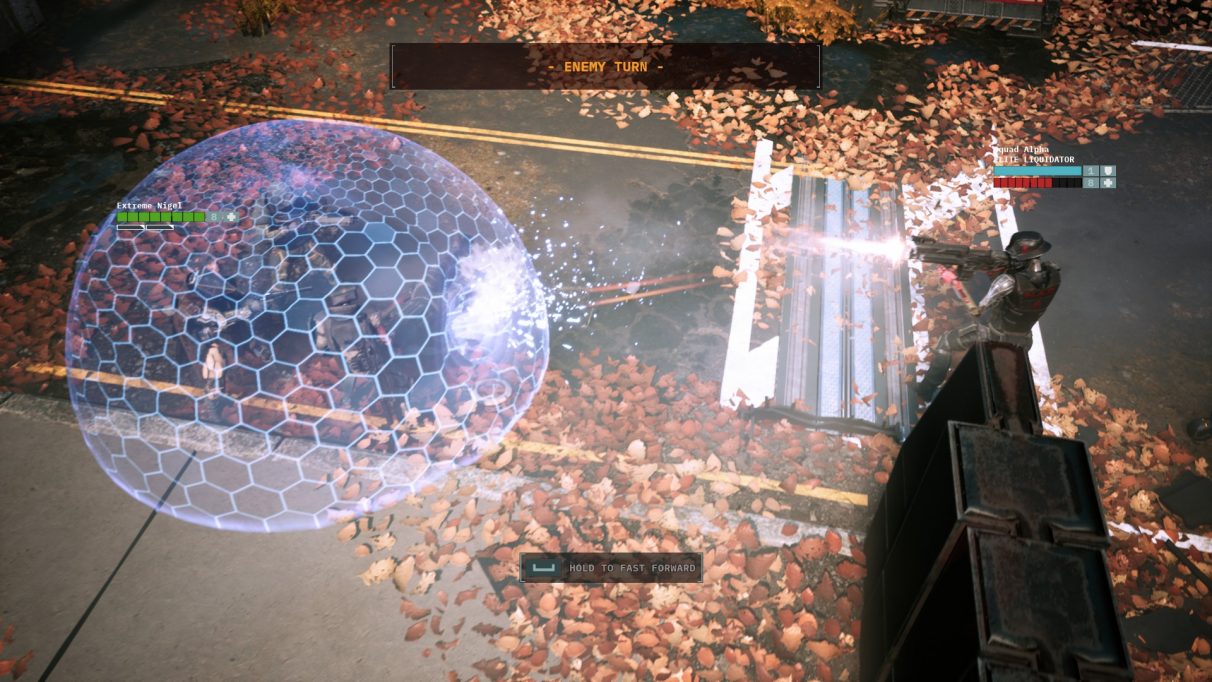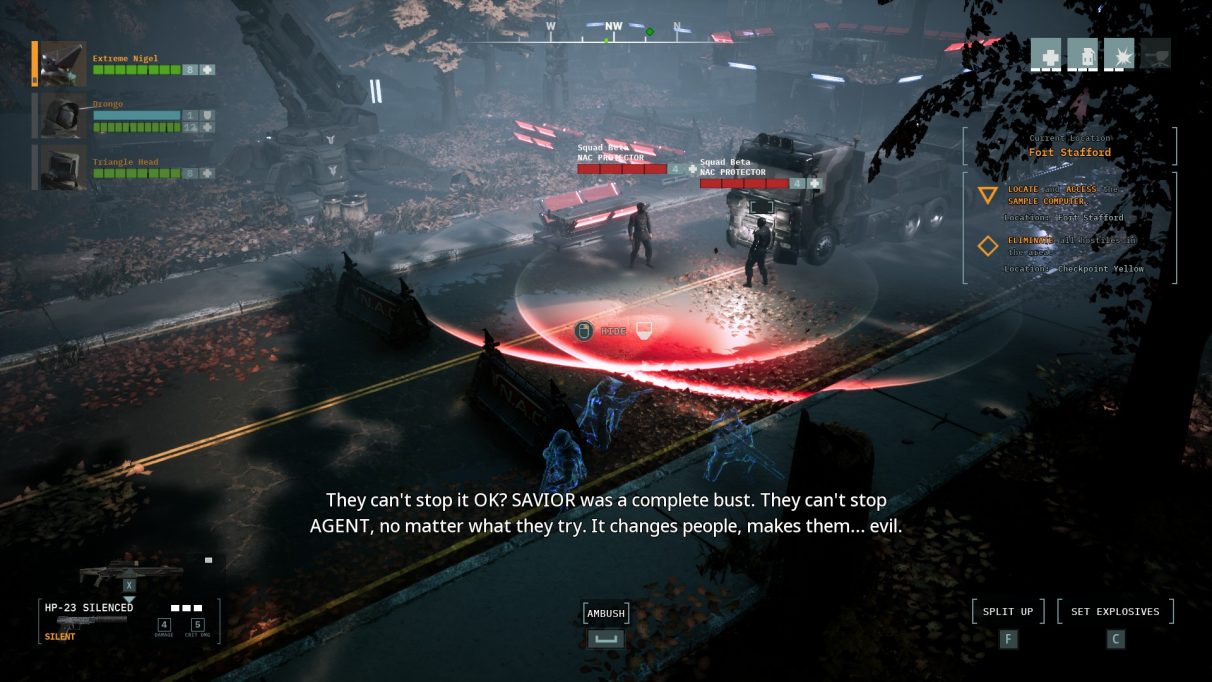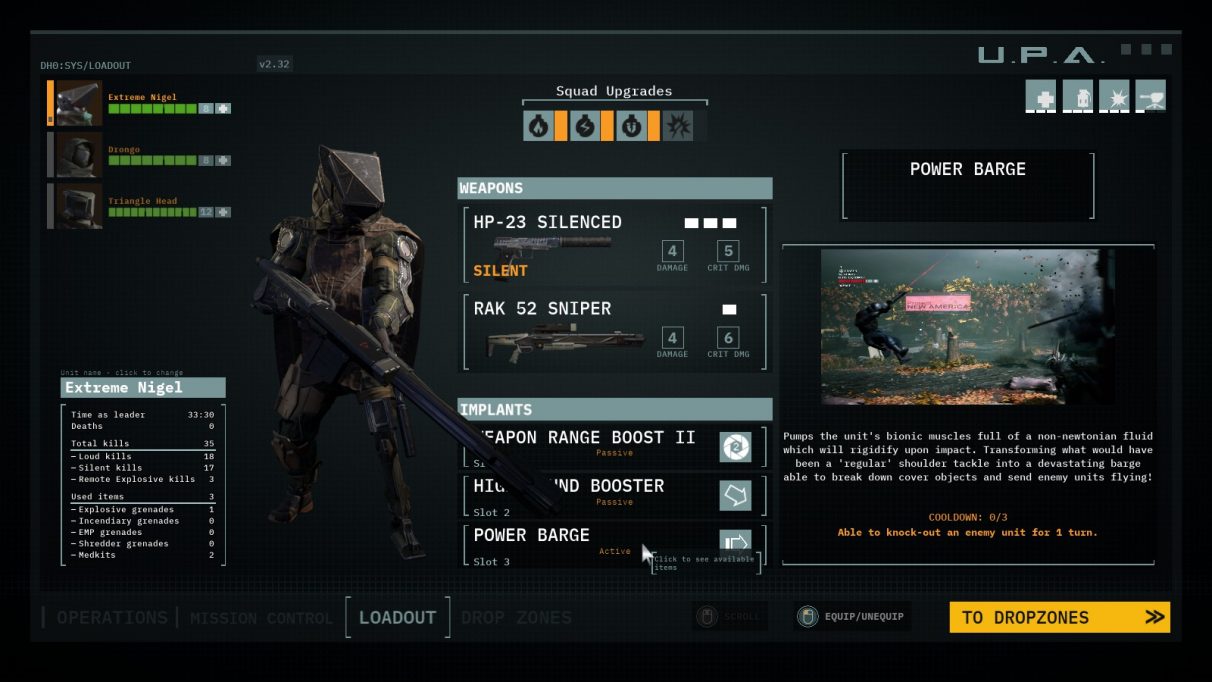MYZ had personality and atmosphere, and that helped carry it through its weaker parts. And here I once again come up against the question of how fair it is to judge a game only in relation to another. Because Corruption 2029 plays very much the same way for the most part, for good and ill.
It’s a turn-based tactical shooter in which you direct three soldiers across a series of maps with a dozen or so enemies dotted about. The standard XCOM-style two actions system applies, with infinite ammunition but small magazines, and most forms of direct attack ending a turn. Stealth pays a huge and very necessary part as you’re severely outnumbered, and ambushing solitary enemies is key. Sounds familiar, right? It’s very shiny, to give it some credit. 2029 is set in a ravaged near-future USA, and its ruined cars and sad autumnal streets look fantastic. Your wee soldiers are intentionally hollow shells of people, but they still have a nice look, all robotic limbs, flowing, flappy coattails, and oversized triangular helmets. Though the warzones are largely static (save for when you’re blowing chunks of them down to get at your enemies), everything in them moves smoothly and convincingly. Gunshots are rewarding and walls and light cover fall apart quite entertainingly when you shred someone next to them with a shotgun, or pap at someone through three walls with your range-enhanced sniper (somewhat raising the questions of why cover is any defence against it, and how on earth it does such paltry damage when it hits a person). So what’s it all about? Well that’s simple. The civil war between Side A and Side B is happening, so you’d better send your mindless automatons to shoot people on the other side, because of reasons. They’re the baddies, although they clearly think you’re the baddies. The extremely brief opening notes that propaganda and misinformation are major factors in the war, and between an occasional mystery broadcast and overheard dialogue from under-murdered guards, it’s obvious that you’re as in the dark as your soldiers.
But it’s not all that interesting with it. America is in a dire state, with a superweapon to shut down and talk of a vague force or condition afflicting distant enemies suggesting an imminent apocalypse, possibly one placing Corruption firmly in prequel territory. But without any meaningful characterisation of either individuals or factions, the stakes feel rather flat. For all I know, my entire faction could consist of just me, my radio support woman, and my three angular meatmen. You fight repeatedly over the same handful of levels, which your enemies repeatedly reoccupy even while talking about a retreating front line. By the third time I sneak-murdered my way across the only bridge in the region, my support woman made a point of how important it was. So why not, y’know, defend it? Can we really not spare four or five guys? Hell, they can borrow my sniper rifle if it means I don’t have to do it again. This isn’t as big a deal as I’m making it sound, but it does identify what Corruption 2029 is. Its plot isn’t bad. It’s just thin, and that’s because it’s dressing for a stealthy turn-based tactical shooter. Your three dudes will always be outnumbered, so each level is invariably a case of sneaking around to case the joint, and identify which of the soldiers are weak enough to be taken out silently, and stupid enough to walk off somewhere on their own. You’ll ambush each one in turn, then move on to the ones with slightly more health, and repeat until everyone’s dead, you feel confident enough to take the handful of survivors in a firefight, or you screw up and have to fight everyone at once.
You will screw up. For much of the game you’ll only have two silenced weapons, neither very powerful, and the only way to gauge a safe distance for loud guns is through trial and error. Alerting everyone will get you killed more often than not. Most guns have very short ranges. “Overwatch” carries the usual problem of soldiers immediately chucking bullets into the wind the instant someone enters range rather than waiting for a clear shot (Jagged Alliance partially solved this over 20 years ago!). Some enemy types can summon an endless stream of kamikaze robots, and others resurrect the dead. So you’re forced to be aggressive and move often to maximise your hit odds, but you simply have too few people for a stand up fight to be a good idea (as Matthew and Alice L found out live). Completing missions and bonus objectives gives you access to better weapons and special abilities, each of which can be swapped around at will in between missions. This is far preferable to Mutant Year Zero’s XP and mutation system, and makes for some entertaining combinations, like a shotgunner who can leap up onto a watchtower, knocking an enemy to the ground, and then blast another one point blank, while your other two wait below to finish them off. Or standing everyone out in the open to get a better angle, then having one of your team drop his magical shield dome that makes them all invulnerable for a turn of counter-fire. You can also get a minigun. Its name is “BOYO MAX”, a fact that would have instantly sold me on the game if I’d seen it early on.
Hit percentages work in 25% increments, damages are all predictable and clearly shown, and you get a lot of control about when and where to start a fight. It even shows you your odds to hit from a new position when you hover your mouse over it, which goes some way towards making the total lack of a move confirmation order tolerable. (Yet another turn-based game missing this in 2020! What the hell is going on out there? 2029 even doubles up by making the right mouse button serve as ‘cancel’ in some areas of the screen, and “move” in others. Christ.) But the slightest mistake can invoke a world of hurt on you. Unless you’ve cleared out enough solo targets already, alerting anyone basically means a slow and attritional game over. Although none of your team permanently die, losing one is usually fatal, and even having one start to bleed out means that another will have to run over to patch him up instead of fighting, and if you were struggling with three guns blazing, losing two for a couple of turns doesn’t exactly help.
To make it even worse, I’m convinced Corruption is a liar. I think it lies about hit percentages. Experimentally I reloaded one shot that was supposedly a 50% certainly 17 times. I got tired of reloading the game before I got a hit. Another shot, supposedly 75% accurate, failed nine times before I gave up. This is possibly just horrendously bad luck - we’re all somewhat aware of how bad our brains are at understanding odds, and in any case it’s common for games to present misleading numbers to compensate, or create a sense of drama. Smoke and mirrors are fine to an extent. But combined with the consequences for missing, it meant that I quickly found myself simply not bothering with any shot that wasn’t 100%. That may even be intentional, but it meant that my squad’s idea of “tactics” was 90% walking directly up to targets and choosing whose gun barrel would go in which orifice before firing. It’s a shame because the less one-sided fights feel terrific when they happen. Basic enemies go down with a couple of hits, blasting people through walls and knocking down their cover with the shotgun (one of a few weapons that can be aimed manually - almost no guns have free aim, and shots count as a binary hit/miss, rather than hitting anything around or behind the target). Limited grenades and remotely detonated bombs make for an occasional very satisfying multiple kill, and I like that you choose a grenade’s effect before throwing it, rather than having to stock up on different types.
But most of the game is stealth and most of your options are not stealthy. As many players of Mutant Year Zero observed, that game was largely a puzzle game with a small shootout at the end, and Corruption 2029’s structure is very much cut from the same cloth. Taking people out always feels good, but the walking around, the waiting for the right part of a patrol route, and the frequent reloads when something goes wrong all get repetitive and a bit draining. It’s a really well made and sometimes great portion of turn-based tactics, but more often than not, it was frustration rather than strategy that drove me to go maximum boyo.





